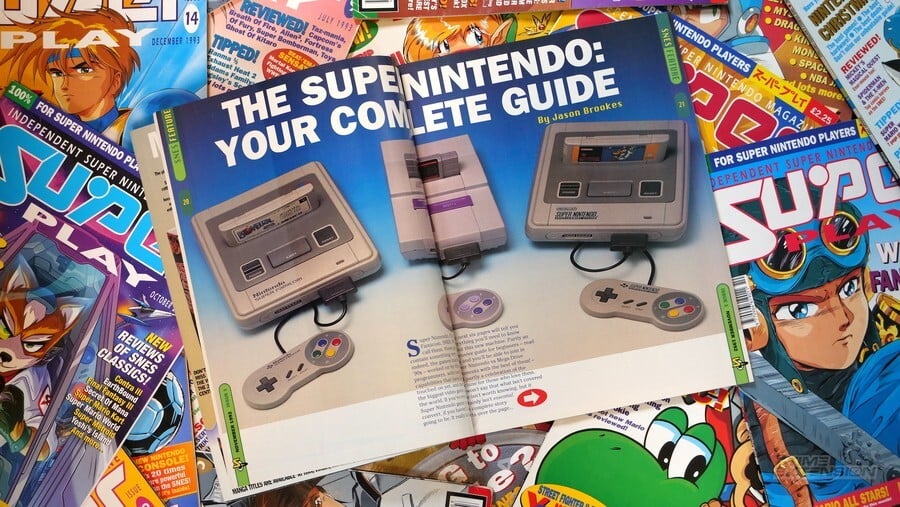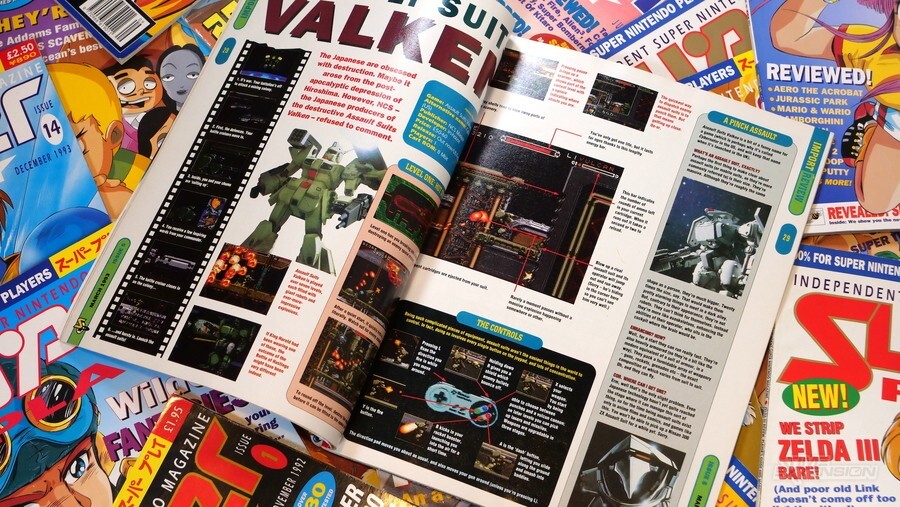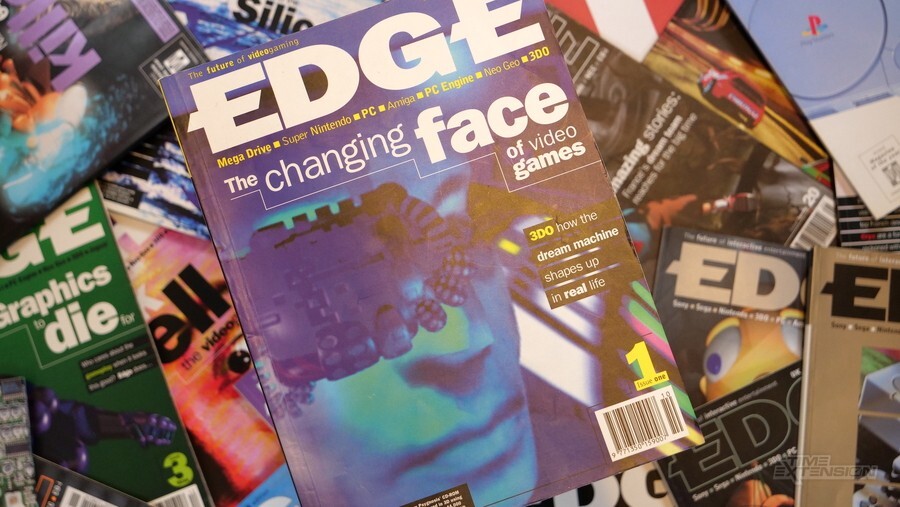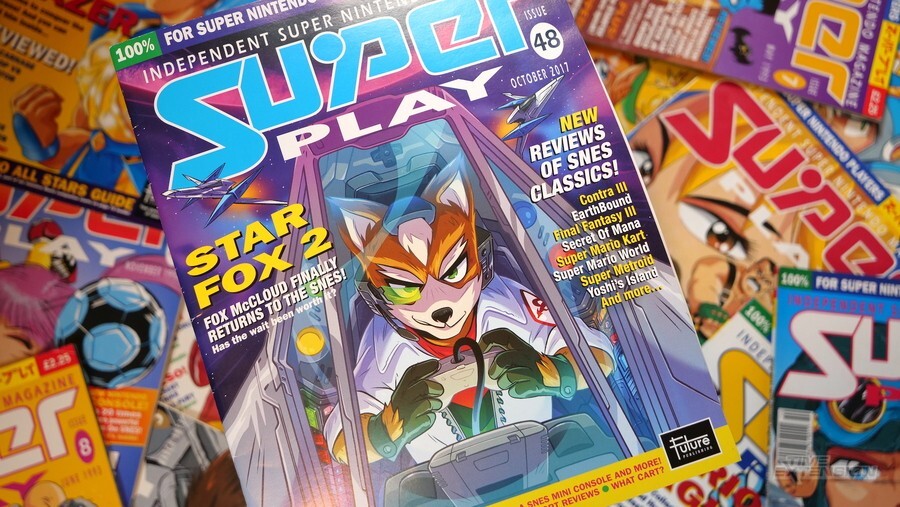
Earlier this week, former Super Play, EDGE and Famitsu staffer Jason Brookes passed away after a long battle with cancer at the age of 52.
We're running a proper tribute to the great man soon, but in the meantime, here's an exclusive interview conducted with Jason back in 2017, but never previously published.
Time Extension: How did you get into games journalism?
Jason Brookes: In the late '80s I was at Manchester Polytechnic and was pretending to be studying when, in fact, I was spending most of my time either playing Amiga games, reading games magazines or playing coin-ops like Rastan Saga and Rygar in the city’s best arcades. Around that time I bought a PC Engine from Console Concepts and had started contributing to a fanzine called Electric Brain – a crudely assembled and photocopied rag by someone in Nottingham called Onn Lee, who, I seem to remember, had a cousin or relative in either Tokyo or Hong Kong who translated the news from Japanese mag Weekly Famitsu for him. This was way ahead of what was being reported about in the regular UK mags so it was pretty on the ball.
I wrote some reviews for it back then as a way to channel my passion about this new, exciting world of Japanese console gaming I was discovering. Funnily enough, sometime before being hired by Super Play I had actually applied for a job at EMAP and went to London for an interview with Jaz Rignall. I remember he was upfront about the harsh financial realities of being a 25-year-old living in London on such a pitiful salary – fortunately, I think they ended up giving the job to Ed "Radion Automatic" Lawrence.
How did you become part of the Super Play team?
At the time in summer ’92 I was working for an incredibly dull North Manchester paper and stationery company as part of a graduate placement program. Thankfully, I soon spotted an ad in The Guardian looking for writers to join Future Publishing in Bath, and sent off a letter and some samples of my writing. Luckily, a publisher called Steve Carey who was launching two new games mags had heard of Electric Brain when I called up and he asked me to come down and meet Neil West (who I later found out was launching the Mega Drive mag MEGA). Neil realised I was a massive SNES head and quickly passed me onto Matt Bielby, who was looking for another staff writer (besides Jonathan Davies who was already on board with the Super Play launch). He offered me the job the same day, which was great!
What was Future like to work for back in the early '90s? What were the working conditions like in the offices in Bath?
It was an amazing time to join Future. The company was on a roll back then – new mag launches were seemingly happening every week and the company was expanding fast into all kinds of other hobbyist markets. The offices were right in the heart of Bath and surrounded by pubs and places to eat where we would get taken out by games PR people frequently for free grub! It was a very socially engaging company and anyone who joined really would have had a hard time separating their work lives from their social lives.
I lived and breathed games mags at that time so I remember just wanting to be there more than anywhere else anyway – even Saturdays I’d be there most weeks checking if that week’s new Famitsu Weekly had arrived through the mail from Japan, or playing games with other staff.
From a gamer's perspective, what were your thoughts when you first encountered the Super Famicom / SNES?
I do actually remember seeing the early SFC prototype photos in Electric Brain and pondering the huge potential of a 16-bit Nintendo – even though I hadn’t been a Nintendo 8-bit gamer, I knew that some of its first-party games like Mario and Zelda were regarded as some of the best games ever made. When I got into home gaming more seriously with the Amiga it was already 1988 and the NES was a crude relic by comparison.
I remember being excited about the early screens of F-Zero and Pilotwings (which back then was called ‘Dragonfly’ I remember) and the promise of scaling, zooming bitmaps that hadn’t yet made an impact on home consoles. Also, a Sony-designed sound chip sounded amazing as I was a huge game music nerd and used to record Amiga music onto tape!
Basically, the PC Engine (and to a lesser extent, the Mega Drive and Neo Geo) had whetted my appetite for Japanese gaming in a big way, but learning about the Super Famicom was perhaps the most exciting gaming launch I’d looked forward to. It was on my must-buy list from that moment onwards, I guess – and the fact that this pre-launch hysteria was all going on in mythical, gaming-obsessed Japan made it all that much more exotic and desirable.
Where did the name "Super Play" come from, and did you have any other alternative titles in mind?
We sat around with a lot of anime mags that Matt has gathered and wanted a name that conveyed the ‘Japlish’ weirdness of a lot of Japanese stuff that used English names. I can’t remember whose idea it was but looking back (probably Matt’s) and at first, I remember thinking it was a little awkward sounding. I still love that logo to this day – especially now I’m a graphic designer who does that kind of design work. It was partly ripped off from Japanese New Type magazine that had a very cool logo we loved.

How difficult was it to establish the tone of those early issues, and how did the team come together?
The tone was set by Matt and Jonathan really, and it made me appreciate how much talent goes into making a magazine a good read, and in Super Play’s case, in particular, a great place to feel included in something exciting. Looking back through the early issues recently, I realised that it must have been so much work for those two since their output in terms of words was so much higher than what I was capable of – I remember the first month or two of the mag was a slightly wobbly time for me confidence-wise because most of the ‘hilarious’ reviews I did were either changed a lot or substantially toned down by Matt. But gradually I understood that there needed to be an overall style and tone that we worked to collectively – warm, friendly and amusing, if possible. Jonathan constantly nailed it, and was a little envious of his dry wit and writing ability.
Super Play had a strong import focus from day one; why did you decide to give Japanese games such a large degree of coverage, and did this ever cause any friction with Nintendo and its European publishing partners, who would have been releasing games on a different schedule in the UK?
Personally, I was fascinated by what was happening in Japan and really wanted to be part of a magazine that communicated that excitement. So Matt's idea for a Japanese-styled SNES mag was really a dream come true in many regards. Japan was obviously the world’s gaming Mecca back then and – true confession! – I actually almost got hired just prior to starting at Future to work as a long-haul cabin attendant by Japan Airlines. I’d literally applied because I was desperate to get to Japan in any way I could, and I remember having some half-baked ideas to import hot gaming gear to resell, also perhaps get a gig as a Japanese correspondent for a UK mag. Just as well it didn’t pan out really, though.
Matt and I definitely saw eye-to-eye on the heavy Japanese slant, although with me he probably got a lot more than he bargained for! I was obsessed with the SFC and Japan and came with a lot of knowledge and enthusiasm to skew things that way as much as possible. As well as our Japanese features and previews, the ‘What Cart’ and section was something I was quite proud of in this regard – you really got a sense that there were all these weird Japanese games out there in the SNES catalogue that you would probably never get to play, but were glad they existed anyway.
As well as embracing Japanese games, Super Play also pushed other elements of Japanese culture with regular columns reporting on the latest crazes in Japan and a healthy degree of anime and manga coverage. Where you all fans on the team?
Not so much to be honest – it was more Matt and Wil Overton who were the anime fans. I loved all the artwork associated with manga and anime but wasn’t such a fan of watching the films or series – although My Neighbour Totoro will always have a very special place in my heart.

Given that Super Play was created in a time before the internet, how hard was it to get solid and reliable information out of Japan regarding upcoming releases and other news?
It’s amazing to think back to us compiling Japanese news back then, pre-internet – where the hell did we get our news from?! Some of our info probably came via publishers or PR people who were doing deals with Japanese game publishers. Or game creators who didn’t mind sharing tidbits from time to time. For second hand, recycled news I remember we relied a lot upon EGM, Famitsu Weekly and perhaps other more hardcore mags, like Diehard Gamefan. Within a few issues, we hired a local Japanese speaker to translate games mags we used to order from The Japan Centre in London. And I remember always pushing for us to order expensive ‘repro’ scans of screenshots from Japanese mags of newly-announced games when we were on deadline – I probably drove the art staff slightly crazy but our timing was often good and we did frequently get good scoops!
What was your relationship like with Nintendo, given that EMAP had the official magazine licence at the time? Were you kept at arm's length or denied any content or coverage?
It was a little fractured if I remember correctly, and we must have been incredibly annoying for Bandai who were the distributors back then for all things Nintendo in the UK. If you basically read the first couple of issues of Super Play and you were a more hardcore-inclined gamer there was a much better chance of you buying an imported American machine than an official UK model – the former, which despite being ugly as sin, was the most convenient way to play American and Japanese imports. I guess, looking back, I am perhaps surprised that we didn’t lose Nintendo’s official SNES advertising.
Was there any rivalry in general between EMAP and Future at the time, given that they were perhaps the two biggest publishers operating in the video game arena?
For sure – because it was clear that EMAP staff cared about games as much as we did, and were a bit more on the ball in terms of exclusives and news than some of our other rivals.
How many issues was Super Play selling each month at its height?
Can’t quite remember the numbers, but it was something around 30,000 I seem to remember.

A series of rival SNES magazines - such as Super Control and N-Force - also appeared at the time. Were you mindful of the competition at all, or were you simply content to do your own thing on Super Play?
Personally I was proud of what we were doing at the time and do remember feeling quite competitive – especially with our timing with regards to new game scoops etc. But to be honest, I probably didn’t need to worry too much – the other mags that appeared at the time probably weren’t staffed by compulsive game info nuts like me... they probably had a life and went home from work on-time more often!
During your time on the magazine, which SNES titles stood out for you personally?
I’d say Super Mario Kart, Street Fighter II and two-player Rampart were easily the most fun games we played in the office. Super Tennis was fun too. Of course Super Mario World and A Link to the Past were the defining titles on the system in the early days, and it wasn’t until I’d moved over to EDGE that later-era classics such Super Metroid, Secret of Mana and Yoshi’s island appeared. I’ve still never played EarthBound to this day, although having just caved and bought a SNES Mini on eBay (as well as an SFC one just for the design and packaging which is dreamy) I’m looking forward to checking it out.
Do you have any memorable anecdotes from your time on the magazine?
Nothing too memorable specifically… but in general terms, working on Super Play and at Future in 1992, was, for myself at least, a combination of untethered, obsessive fandom and 'is-this-really-a-paying-job?' bewilderment. The truth was, for a lowly staff writer it was barely a paying job at that time, but my living expenses were so low that it didn't really matter. I lived about a minute’s walk from the office, paid about a hundred quid rent every month – life was really very simple. When I wasn't reviewing bad THQ games I pretty much dedicated my efforts towards making sure we had the best Japanese news, previews and hardcore game-y feature content. I think they cut me some slack in that sense, because when I look through those old mags now I barely see any reviews by me, and I know Matt and Jonathan were churning them by the dozen!
When the N64 was released the decision was made to retire the Super Play name and relaunch as N64 Magazine. Do you agree with the many fans who believe that this was essentially the spiritual successor to Super Play?
Oh yes, N64 mag was brilliant, even though I was living in the US by then and didn’t get to see it very often. It was probably one of the best-loved games mags Future has done – perhaps not as well remembered as Super Play, only because the console and its games arguably haven’t aged as well.
What have you been up to since departing Super Play?
I moved onto EDGE as a writer after issue 9 of Super Play and did feel very sad about cutting my time on such a cool mag short. But my passion was ultimately multi-format gaming and I always had a keen eye on what was coming next. EDGE was a very lucky streak for me – Steve Jarratt moved off after just 9 issues and I got to take the top job. Kind of ridiculous when I think about it – I was so inexperienced.
After running EDGE for 50 issues I moved to California where I lived for a long, long time in San Francisco as a salaried US correspondent for a Japanese PC mag called LOGiN, and later contributed (ironically after all those years of nicking their news) to Famitsu Weekly. Now I’m back in the UK and have mostly abandoned games journalism in favour of a similarly lowly paid profession: graphic design. I also have a bunch of retro-inspired gaming illustration projects that I’ll hopefully be sharing in the form of screen-printed posters and Tees shortly. Watch this space!
Future has recently resurrected Super Play for one issue only. Was it strange to see the magazine back on newsagent's shelves after all these years, and what the emotions did it stir?
Yes, it turned out great and I really enjoyed contributing to it. Wil’s Star Fox 2 cover looked fantastic, I thought. Also, the fact that it was bundled with Retro Gamer which had a PC Engine feature cover feature was the cherry on a long-overdue cake. I suppose I only wish they’d been a bit more digging into the mag’s creation!
Why do you think Super Play is so fondly remembered by its fans more than 20 years after it ended its original run?
I think I wrote in Super Play issue 48 that the feeling of being part of a club was endemic in Super Play. When you bought the console and then perhaps subscribed to the mag I would imagine it felt like you had a joined up with an extended bunch of friends who also felt as excited about the future of the console as you did. We had had a basic plan to create a cool, personality-driven games mag for the SNES with a heavy Japanese angle.

Matt and Jonathan knew about writing and magazines in a way I really didn’t, but I knew the Super Famicom's upcoming Japanese release schedule like the back of my hand, and so it was a good pooling of skills that resulted in a winning combination: hardcore, authoritative reporting with a strong, personality-driven tone.
What actually struck me most recently when looking through my Super Play binder of the first year of issues was just how dense with content the magazine was – it was really packed to the gills with all kinds of cute little lists and charts and random things... barely any space was wasted at all!
This article was originally published by nintendolife.com on Thu 5th December, 2019.







Comments 25
..Well damn 52 is way too young.
I still have a few issues of Super Play lying around should reread them in remembrance of Brookes at the very least.
Video gaming magazines were so much more fun, for lack of a better word, back then.
They had so much more personality.
I used to buy Superplay back in the day the covers where always amazing and detail inside the magazine's i wish i still had them all.
Sad to hear. I was addicted to Super Play! I kept all of the Final Fantasy Corner articles. I ADORED those.
I loved Wil Overton's art and for that reason decided to collect N64 Magazines for a long time after Super Play. I even got featured once with some fan art that I drew, of which I was really proud.
I decided to reach out to Wil Overton a couple of years ago to thank him. He was a really nice guy, e-mailing me back and forth for a little while.
Man, Super Play was awesome!!
A bittersweet article.
Super Play was without doubt the greatest gaming magazine, as a 44 year old I still look at my old issues even now. I’ve bought and sold many games and consoles over the years but these magazines will stay with me forever.
A time in gaming that will never, ever be repeated, when you could go into WHSmiths and there were maybe 20-30 different gaming mags available yet Super Play stood out.
Rest in peace Jason
I have question for anyone who owned the Super Play Magazines. On the What Cart? section of the article there is a game listed titled "Kings Quest V" and published by Bronson. I tried looking for it on gamefaq specially the publisher but no avail. Any guess anyone on the game but its not Dragon Quest V or Serria's adventure game of the same name.
I used to read it too and absolutely loved it, RIP Jason
N64 Magazine was also awesome.
Wish I stil had mine .
Oh goodness. I can’t believe he’s died, so young too.
I downloaded most, if not all, copies of Super Play in pdf format from various places on the internet a couple of years ago, and read them all. Despite completely missing this magazine back in the day, I got completely sucked into the ‘club’ like I was there at the time. You really felt their enthusiasm for the SNES and Super Famicom, especially the JRPGs that either only made it to the US, or never left Japan.
I’m gutted to hear about his death 😞
RIP Jason. Thank you from the bottom of my heart for helping make Super Play a foundation for my love of all things SNES.
The Commodore Amiga might have made me the man I am today, but it was Super Play that made me write for Nintendo Life. RIP good sir.
I echo the above comments and also thank Jason from the bottom of my heart. Super play came into my life at a very special point, replacing mean machines after it had split in two, as my favourite mag. By that time I had a SNES and a few games already, and loved reading about all the import games and anime in my early teenage years. I think I wasn’t alone in this, and look back at this time as a defining era for my love of the super famicom, anime/ manga and Japanese culture in general. He touched so many people with his work
I'm very sorry to hear of Jason's passing. As a key member of the Super Play team in its first nine issues he helped define the culture of the magazine, and still found time to contribute to the magazine even after leaving to join EDGE, and this interview seems to show he never lost his love for the quirky sides of gaming. Oyasumi, Jason, arigatō!
R.I.P. Jason
I started reading super play from issue 12 as I couldn't find the latest copy of N-force. I never did pick up another copy of N-force after that. A year later I worked at burger king and a matey boy sold me the first 12 issues. I read them and loved them.
Awful news and far to young. Great read,it really does make me miss the height of gaming magazines.
Wasn't there a magazine called Total that was Nintendo focused that came out before Super Play?
The sense of humour and inclusion I got from reading Super Play was second to none. You felt like you really were part of something special and irreverent when turning its pages. It's a publication that to this day has still never been bettered. RIP Jason.
@HalfAWorldAway There was. Think it was a different publisher. Wasn't half bad.
@HalfAWorldAway Yeah, I collected those too, before I found out (way late) about Super Play. It was a fun magazine, but I liked Super Play better for its J(RPG)-centric approach.
@Electric-Dreams TOTAL! was also a Future publication. That ended shortly after Super Play did.
To be fair, TOTAL! deserved ignominy for giving the dreadful Rise of the Robots 77%.
RIP Jason and thank you for contributing to a magazine that helped define my world view and inspired me to go and work in Japan. The magazine was awesome. I remember the first issue I bought was the super play gold special, which was awesome! Good times, the magazines are still a fantastic read today
Great read. Thanks for giving us this insight.
Rest in peace, Jason-san.
@HalfAWorldAway Yes indeed, I bought probably the first 10 issues, it was edited by Steve Jarratt who later started Edge.
@antster1983 Pretty sure they gave Super Mario Kart ‘only’ 82% as well.
@Eddsnake Just looked it up. They did indeed. 🤦♂️
Tap here to load 25 comments
Leave A Comment
Hold on there, you need to login to post a comment...